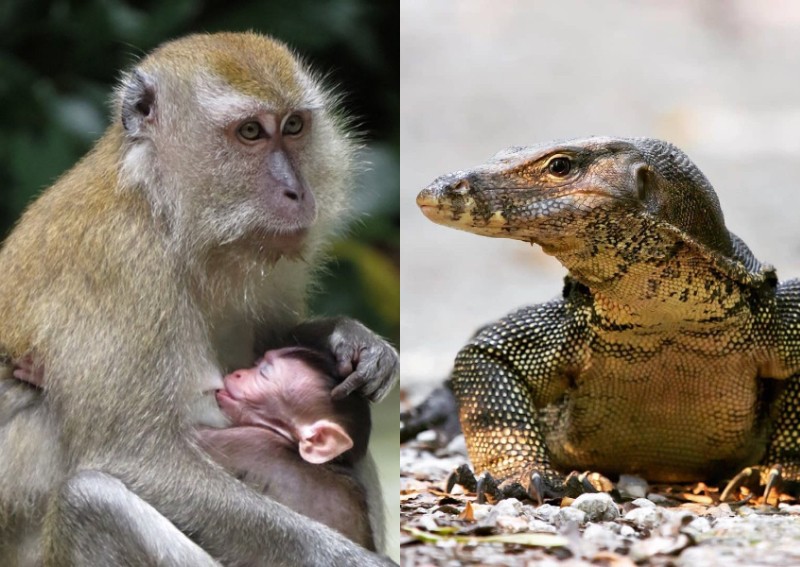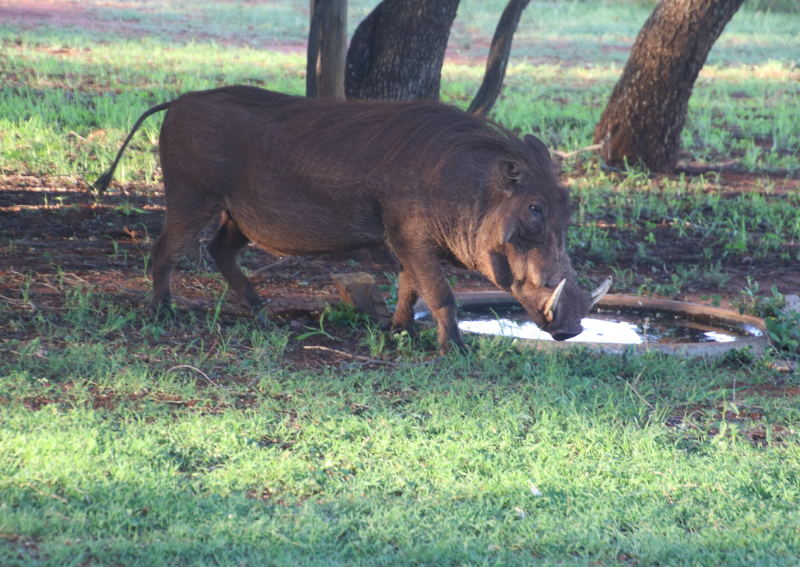World Wildlife Day: If you come face to face with these critters, how ah?


Singapore is often described as a small island and referred to endearingly as the Little Red Dot. Nevertheless, we have a land area of 728.3 square kilometres that, according to National Parks, contains an estimated 23,000 to 28,000 species of terrestrial organisms.
No wonder it's so easy to bump into an 'uwu' bird around one corner, and cross paths with a monitor lizard at the next!
But what if we were out hiking and rediscovering our backyard (an activity that has seen a sharp rise in popularity since Covid-19 hit our shores last year, preventing us from travelling) or walking home from buying groceries, and found ourselves face to hairy face with a wild boar? Or your productive WFH and HBL plans are thwarted by the 'uwu' bird outside your window?
To commemorate World Wildlife Day (March 3) — a United Nations International day to celebrate all the world's wild animals and plants, and the contribution that they make to our lives and the health of the planet.
Here's a list of do's and don'ts when you encounter certain kinds of wildlife in Singapore, for your safety, but, more importantly, for theirs. If nothing else, just remember: see, no touch.
[embed]https://www.youtube.com/watch?v=_EZ66v4T7Zw[/embed]
If we had a national bird (actually, there's an unofficial one — the crimson sunbird), this could very well be it. The old English proverb that children should be seen and not heard could very well apply to the Asian Koel, although, truth be told, the large, midnight-blue cuckoo bird with blood-red eyes is not something you'd want to set your eyes on during Seventh Month.
This bird is a brood parasite, meaning it lays its eggs in another bird's nest — usually the house crow's — and shoves one of the host's eggs out of it to make way for its own. The blur host unknowingly raises the Asian Koel chick (which hatches first), and it's a case of survival of the fittest.
Now, what if this vocal specimen happens to roost on a tree outside your window? You can try approach your town council or condo management for assistance, but you'll most likely have to bear with the cacophony while it lasts.
Meanwhile, National Parks Board (NParks) is working with the National Environment Agency and premise managements to prune trees, and remove crows' nests and food sources to discourage Asian Koels from roosting in residential areas.
Just remember, 'uwu' win some, you lose some. Just be thankful they don't come in a flock!
[embed]https://www.youtube.com/watch?v=-Qd2OfpLbXQ[/embed]
Firstly, the good part: bats are important pollinators for edible fruit plants such as papaya and durian — they keep the insect population (which forms part of their diet) in check.
Secondly, you don't have to worry about the ones here carrying any transmittable zoonotic virus (including Covid-19), according to NParks' biosurveillance programmes. For some FAQs on bats in Singapore, like "do bats attack people?" — the answer is "no", not unless you provoke or try to handle them. Click here to know more.
If a bat is trapped in your home, injured or distressed, call the Animal Response Centre at 1800-476-1600. Let the pros help you. Please don't try to be brave and handle the bat yourself as you may make it even more agitated and cause it to bite you in self-defence.
[embed]https://www.youtube.com/watch?v=bqbIf3Oil7g[/embed]
Some species will sting if their hive is disturbed, so if you're thinking of smacking a nest of these stingers down with a broom, don't.
If you see a bee hive or wasp nest in a park, keep your distance or notify NParks at 1800-471-7300.
If they start attacking, here are some tips:
If you do get stung, especially multiple times, seek medical attention immediately, especially before allergic reactions start to occur.
[embed]https://www.youtube.com/watch?v=zA234R-aAyA[/embed]
These have highly poisonous stings, so if there are signs that clearly state "Box Jellyfish Spotted Here", don't enter the water and tempt fate.
If you do need to scratch that sea-sport itch:
Box Jellyfish stings covering more than half a limb are considered life-threatening. So if you encounter someone who has been stung by one, and is in distress or great pain, get them out of the water and call 995 immediately.
Meanwhile, remove any tentacles with a towel or tweezers, and not your hands as this could cause the tentacles to discharge more venom.
[embed]https://www.instagram.com/p/B9yfJXGjIar/[/embed]
Also known as the Saltwater Crocodile, this reptile can grow to more than five metres in length. Do not be unnecessarily curious and start prodding or poking it, or even worse, feeding it. It will attack, whether in the water or on land. Just stay calm and back away.
[embed]https://www.instagram.com/p/CP51OarhgqV/[/embed]
Regularly spotted along the Singapore Strait, some females have been spotted coming ashore at East Coast Park to lay eggs. Again, don't be unnecessarily curious and disturb it.
But if you must observe this wonder of nature, do so while talking softly and not using any flash photography or shining a torchlight at it. Light and noise may frighten the turtle and it could leave without laying any eggs. Most importantly, do not touch it or its eggs.
And do not disturb any of the tracks it leaves in the sand as researchers use this to identify the species and locate its nest. Call NParks at 1800-471-7300.
[embed]https://www.instagram.com/p/BqzGNNhg6f4/?utm_source=ig_web_copy_link[/embed]
The best way to keep macaques (or monkeys, general) at bay is: don't feed them, don't have contact with them.
Feeding monkeys will discourage them from foraging in the forest, and will spark a curiosity to search for and hang around for more food.
If there's a troop of these prying primates loitering in the vicinity of your home:
If you encounter macaques in the open:
[embed]https://www.instagram.com/p/CKdvjHZD4sX/[/embed]
There are a few species of this large lizard, and they can vary in length between one metre and three metres. These shy scavengers do have venom, which is used to kill small prey, but has only a mild effect on humans.
If you encounter one:
[embed]https://www.youtube.com/watch?v=J7f6s2g8C0I&t=28s[/embed]
In recent years, we've learnt how to live with these semi-aquatic mammals that belong to the weasel family. While the natural reaction is to go "Eh!! Otter!!" and rush forward to take pictures of the bevy, don't.
If you encounter a family of otters, observe them from a distance, and:
[embed]https://www.youtube.com/watch?v=oWv_SJ9Cz8k&t=28s[/embed]
These shy, nocturnal and solitary mammals (also known as the Scaly Anteater) are super poor thing — not only are they endangered, they also face habitat loss due to rapid urbanisation, and often get injured or killed by vehicles.
If you encounter one, don't be alarmed — it will probably be more scared of you than you will be of it. Don't chase or corner it. Observe it from afar and be grateful for having this magical encounter with a rarely seen critter.
If you witness any poaching of these creatures, call NParks at 1800-471-7300.
[embed]https://www.instagram.com/p/CNgvGvegI_h/[/embed]
Where to start? Did you know that there are over 60 species of snakes that are native to Singapore?
The best thing to do if you encounter one in your home is to, as hard as it may seem, remain calm, keep your distance from it, but keep an eye on it and where it heads to. And call NParks at 1800-476-1600 immediately.
Even if you're not afraid of snakes, do not attempt to pick it up, especially if you can't identify the species.
If you're brave enough, take a towel and hold it out in front of you and approach the snake slowly. When you're close enough, cast the towel over the snake so that it's head is covered. This will not only calm the snake down (since it won't be able to see anything outside of the towel over its eyes), and buy you some time to clamp the towel down with some heavy objects.

If you encounter one, move slowly away from it, especially if it has piglets. An adult boar with young will be in full protective-parent mode.
Keep a safe distance from it, don't feed it, and don't provoke it by wanting to take pictures of it or doing a TikTok with loud music, or worse, using flash photography.
Otherwise, it might charge at you — and show you clearly who's in charge.
This article was first published in Wonderwall.sg.
ALSO READ: Left for dead: Otters invade Serangoon Gardens home and 'rip out eyes, fins and tails' of pet koi